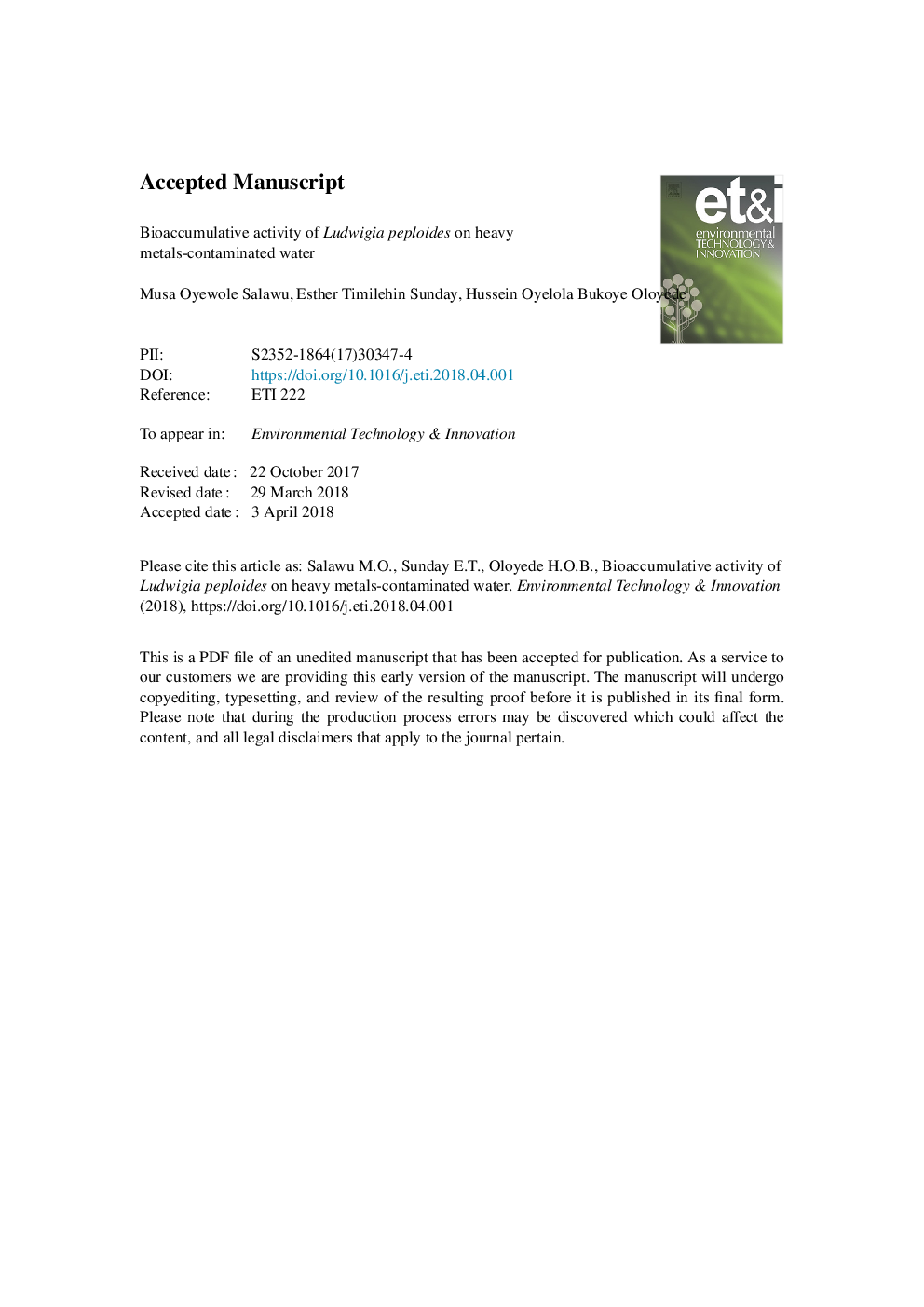| کد مقاله | کد نشریه | سال انتشار | مقاله انگلیسی | نسخه تمام متن |
|---|---|---|---|---|
| 8858028 | 1619278 | 2018 | 37 صفحه PDF | دانلود رایگان |
عنوان انگلیسی مقاله ISI
Bioaccumulative activity of Ludwigia peploides on heavy metals-contaminated water
دانلود مقاله + سفارش ترجمه
دانلود مقاله ISI انگلیسی
رایگان برای ایرانیان
کلمات کلیدی
موضوعات مرتبط
علوم زیستی و بیوفناوری
علوم محیط زیست
شیمی زیست محیطی
پیش نمایش صفحه اول مقاله

چکیده انگلیسی
Heavy metal pollution of soil and water has become a serious environmental problem in recent decades. This study was carried out to investigate the Ludwigia peploides bioremediation activity against heavy metals-contaminated water. The plant Ludwigia peploides was collected from Asa River, in Ilorin Kwara State, alongside with the water sample. The pond water collected was distributed into six (6) different 5-litre buckets (Grouped A-F) in which the plant was cultivated for experimentation within a period of 28 days in the laboratory. Group A served as the control which contained only the natural environment of the plant, Groups B, C and C contained added 5.0 mg/litre Cu, Pb and Cr respectively in the form of CuSO4, PbNO3 and K2Cr2O7 respectively. Group E contained 0.5 mg/litre added Cd in the form of CdNO3 while Group F contained 500 mg/litre added Zn in the form of ZnSO4. The Percentage removal efficiency, Translocation factor, Bioconcentration factor and Bioaccumulation coefficient of the plant leaves and roots were evaluated. Also, activities of superoxide dismutase (SOD) and catalase; MDA, chlorophyll and proximate composition of the leaves were evaluated. There was significant increase (p<0.05) in the chlorophyll-a content of all the test samples when compared with the control. There was also significant increase in the MDA concentration in the plant leaves and in the catalase specific activity of the plant cultivated with chromium, lead and cadmium. There was significant reduction (p<0.05) in SOD activity of the plant cultivated with chromium and zinc at the early stage of cultivation. The translocation factor (TF) of the plant ranges between 0.10-2.11 while the bioaccumulative coefficient (BAC) ranges between 0.10 and 2.68. We therefore conclude that the roots of Ludwigia peploides have ability to remove copper from contaminated water effectively, and to a moderate extent chromium, lead and cadmium. Also, the leaves of the plant absorb high percentage of chromium from the contaminated environment. This study evidenced that Ludwigia peploides may serve as an effective bioremediation agent for correcting contaminated water.
ناشر
Database: Elsevier - ScienceDirect (ساینس دایرکت)
Journal: Environmental Technology & Innovation - Volume 10, May 2018, Pages 324-334
Journal: Environmental Technology & Innovation - Volume 10, May 2018, Pages 324-334
نویسندگان
Musa Oyewole Salawu, Esther Timilehin Sunday, Hussein Oyelola Bukoye Oloyede,